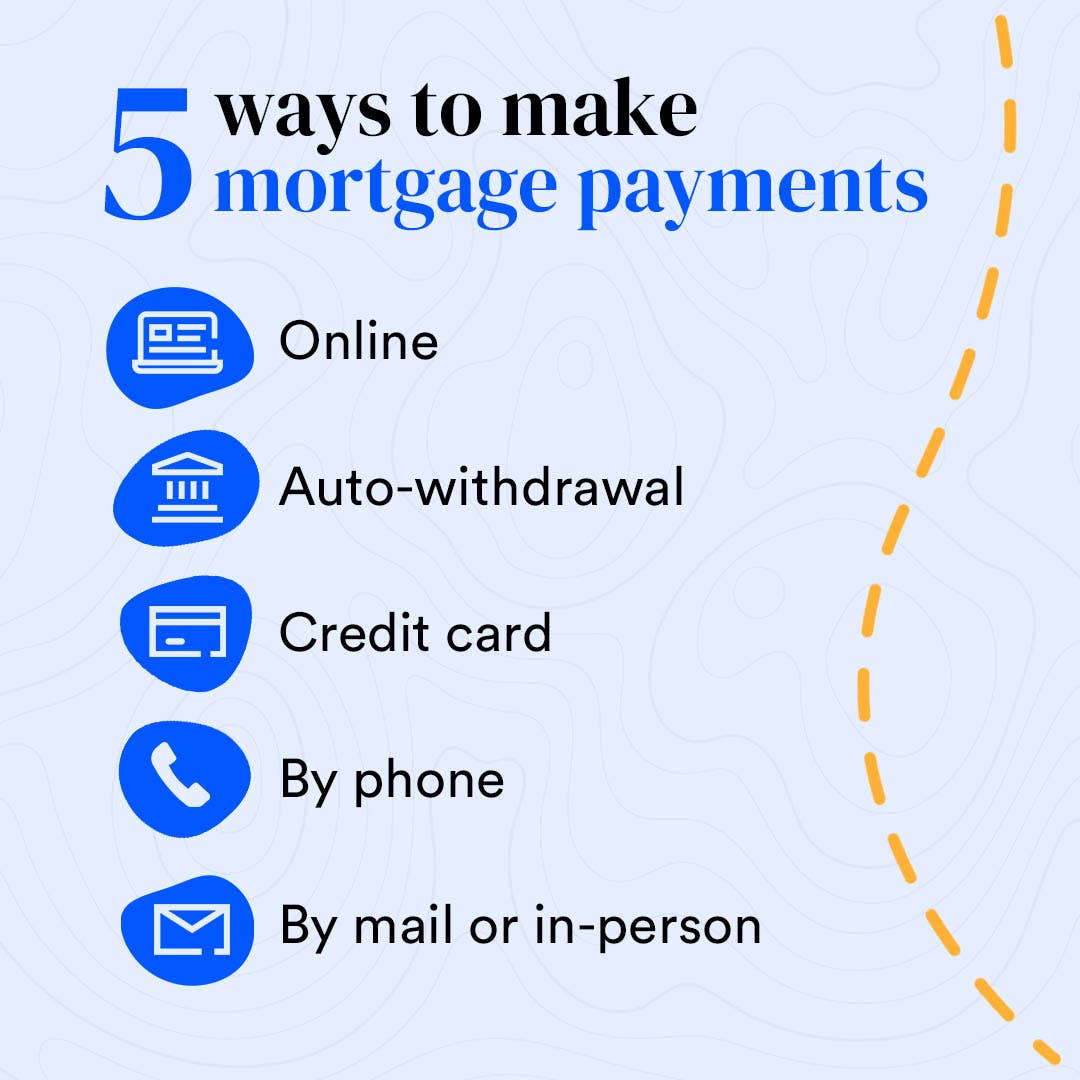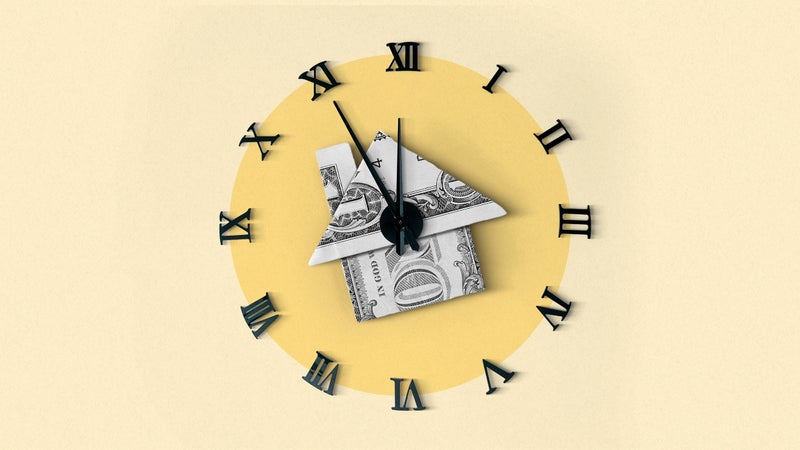How to pay a mortgage: 5 ways to pay on time

The Bankrate promise
At Bankrate we strive to help you make smarter financial decisions. While we adhere to strict , this post may contain references to products from our partners. Here's an explanation for .
Key takeaways
- You can make your mortgage payment through your lender's website or mobile app, in person at a branch or by calling them.
- Many mortgage lenders offer a grace period of up to 15 days after the due date before charging a late fee.
- If you know you're going to be late making your mortgage payment, reach out to your lender to discuss your situation, as it might be able to help you.
Paying your mortgage on time helps you build equity in your home. Doing so can also improve your credit score and keep you from falling behind on your loan payments. Many lenders offer multiple ways to make a mortgage payment, such as paying online or over the phone.
How to pay a mortgage
Your mortgage payments are due on a monthly basis, though you can choose to make payments more frequently. To keep on top of these payments, it’s important to use the payment method that works best for you. Here are five ways to pay your mortgage and what you should know about each method.

1. Pay your mortgage online
The easiest option for most homeowners is to pay for their mortgage through their lender or loan servicer’s website. Making an online mortgage payment is fast, free and efficient. Plus, paying online means you can decide when you want to make the payment, maintain a record of when you made it and ensure that you pay it by the due date. Some lenders also have free mobile apps where you can access your account online and pay your mortgage from your phone.
“Going to your lender or loan servicer’s website and making the payment puts you in control of the timing,” says Greg McBride, CFA, chief financial analyst for Bankrate. “The downside is that this is something else each month you need to do or be reminded to do.”
2. Pay your mortgage with automated withdrawals
Choosing automated withdrawals pulled from your checking or savings account is another easy option to make sure you pay your mortgage on time each month. This means your lender automatically withdraws the mortgage payment from your bank account on a specific day each month.
“Automatic payments via ACH withdrawal are the easiest way to make the monthly mortgage payment,” says McBride. “It happens without the homeowner needing to take any action and it can happen even if you’re away on vacation and completely unplugged. The only downside is for those that have trouble with overdrafts as you need to make sure the money is in the account and available for immediate withdrawal each month when the payment is taken out.”
Still, setting up automated withdrawals can help homeowners who want to make additional or biweekly payments to pay off a mortgage early and cut the total interest they pay over the loan term.
3. Pay your mortgage using a credit card
Making mortgage payments by credit card can be tempting, especially if your card offers great rewards or substantial cash back. Unfortunately, many mortgage lenders are not fans of this option.
“Most lenders won’t accept credit card payments for the mortgage and the services that do offer the ability to pay via credit card tend to charge a service fee that offsets the value of any rewards you’d be earning,” says McBride.
4. Pay your mortgage by phone
Making a mortgage payment over the phone is another option, especially if you forgot to mail in your payment before the due date or have not set up a payment process online.
You can find the phone number to call on your monthly bill or online. Before dialing, be prepared with your mortgage account number and your banking information, such as the routing and account numbers.
Payments over the phone are typically credited to your account quickly. Before you make the payment, though, ask your servicer if there is a charge for this convenience.
5. Pay your mortgage in person or by mail
If your mortgage servicer is local, the company might accept payments by check or money order in person. Money orders are secure payments since they do not include any personal information. But they have one major drawback: The amount of a money order is often limited to between $700 and $1,000.
Another option is to use a certified check or a cashier’s check, which do not have limits.
When mailing a check, make sure you include your mortgage account number on the check. Just having your home address may not be sufficient, even if it matches the address your servicer has on file.
Sending a payment by mail, however, means you have to consider the time it takes to mail your payment and for the servicer to process it.
How to pay off your mortgage faster
Paying down your mortgage faster can help you save on interest over the life of your loan. Early payoff isn’t always the smartest choice, though; for example, if you have other high-interest debt, it might be better to use extra funds to pay down that debt first.
Paying down your mortgage faster comes down to paying more of your mortgage principal. You can do this in various ways, including:
- Making bi-weekly payments: If you have the extra cash, making biweekly mortgage payments — which amounts to 13 full monthly payments per year instead of 12 — can help you pay off your loan faster and save on interest costs.
- Paying every four weeks: If you pay every four weeks instead of every month, you’ll make roughly an extra mortgage payment every year. This small change can add up over time.
- Paying extra on your monthly payment: If you have a little extra every month, you can tack it onto your mortgage payment and pay down your mortgage faster.
- Making a lump sum payment: If you’ve received a large sum of money, you can put it toward your mortgage balance. This will trigger a mortgage recast and will lower your monthly payment.
Just make sure that your servicer applies any extra payments to your principal. Also, look at your mortgage contract to see if your mortgage has an early payment fee.
What if I’m late making a payment?
If you know you’ll be late making a mortgage payment, reach out to your mortgage servicer as soon as possible. Explain your situation and see if the servicer can work with you and waive any late fees. Communicating proactively can go a long way.
Note that there is typically a grace period for late payments, too — usually 15 days.
If you know you’ll be unable to make a mortgage payment for several months, ask your servicer for forbearance. With forbearance, your servicer can reduce or pause your mortgage payment entirely for a set time. If the problem is permanent, ask your servicer for other relief options such as a loan modification. Most servicers are willing to work with borrowers to ensure they continue to make mortgage payments on time.
Frequently asked questions about paying your mortgage
-
Your mortgage payment is made up of four parts: principal, interest, taxes and insurance. If you have a conventional loan, you’ll need to pay for private mortgage insurance (PMI) if you put down less than 20 percent of the home’s purchase price. An FHA loan also requires mortgage insurance premiums that vary based on your down payment size.
-
To ensure you always pay your mortgage on time, consider setting up autopay from your bank account. Keep in mind that most mortgage payments are due on the first of the month, so make sure you have enough of a balance to help you avoid a bank overdraft fee.
Alternatively, if autopay puts you on edge, you can set a reminder on your phone or calendar to pay the bill. Be sure to build in a buffer of 1-3 days of processing time.



